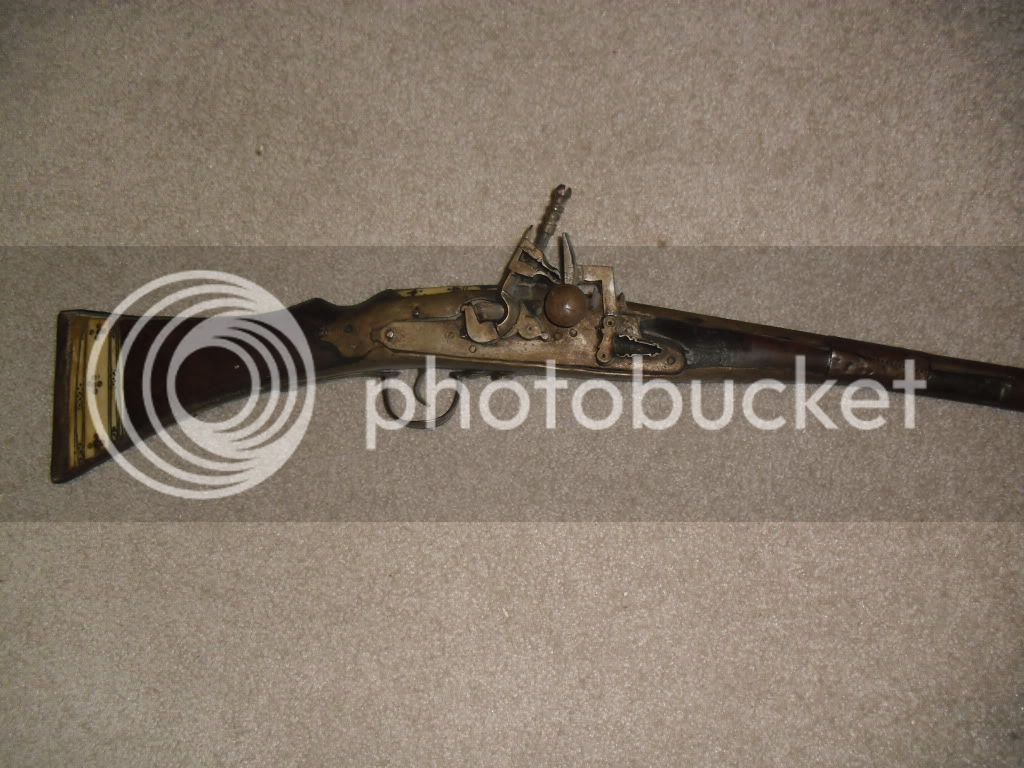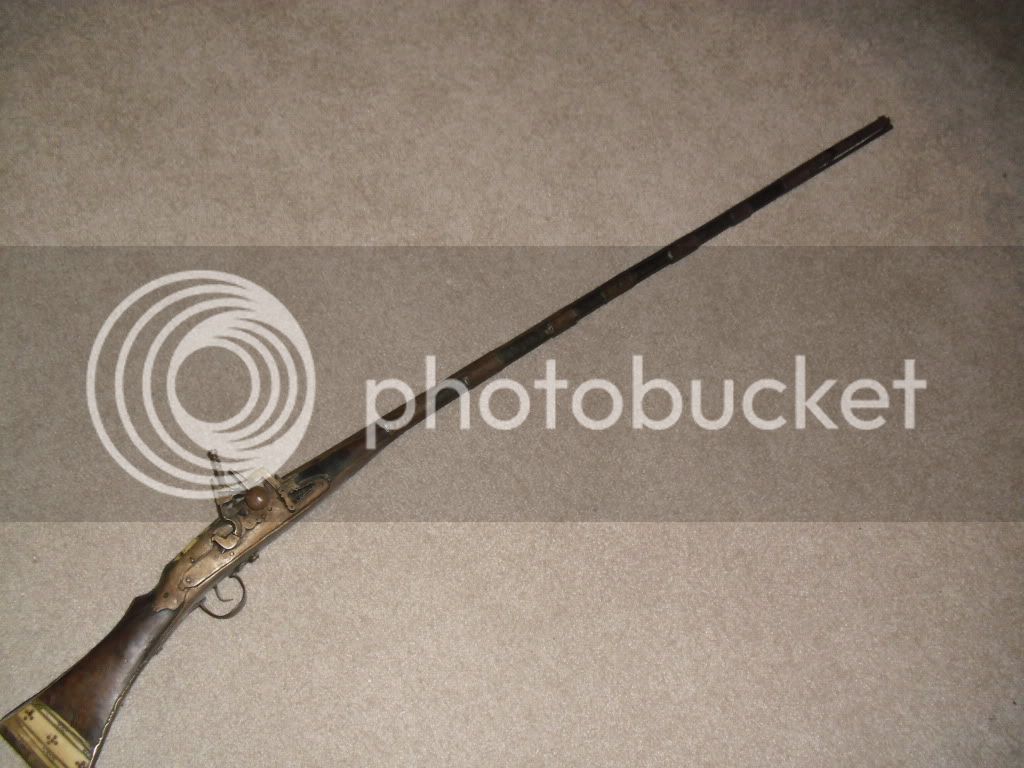I received this gun from my father who picked it up while in the service in morocco spain. There are no marking that I can see on it. As for the powder horn, I'm not sure where he picked it up. I dont know anything about either of them and would like to see if anyone can help me. I also would like an idea of what they are also worth, not for selling but curiousity. they mean alot to me. Can anyone help please?

















-
Friends, our 2nd Amendment rights are always under attack and the NRA has been a constant for decades in helping fight that fight.
We have partnered with the NRA to offer you a discount on membership and Muzzleloading Forum gets a small percentage too of each membership, so you are supporting both the NRA and us.
Use this link to sign up please; https://membership.nra.org/recruiters/join/XR045103
You are using an out of date browser. It may not display this or other websites correctly.
You should upgrade or use an alternative browser.
You should upgrade or use an alternative browser.
what is this? help please
- Thread starter jherrmann
- Start date

Help Support Muzzleloading Forum:
This site may earn a commission from merchant affiliate
links, including eBay, Amazon, and others.
roboskittle
32 Cal.
- Joined
- Nov 6, 2009
- Messages
- 35
- Reaction score
- 0
Pictures are not working.
ohio ramrod
75 Cal.
- Joined
- Aug 21, 2008
- Messages
- 7,473
- Reaction score
- 2,208
Welcome to the club! :idunno:
You cannot use the directory path on your "C" drive. To be seen, the images must reside on a computer that is accessible to the Internet.
Here's the image you have on the Kodak site...
http://www.kodakgallery.com/imaging-site/services/doc/5582:993689930215/jpeg/BG
Here's the image you have on the Kodak site...
http://www.kodakgallery.com/imaging-site/services/doc/5582:993689930215/jpeg/BG
Last edited by a moderator:
Can anyone please tell me about my flintlock and powder horn. I received them from my father who got them in morocco while stationed there for the airforce. He believes they are from casablanca and were used by the berbers, which I was informed are some mountain horse wranglers.There are no markings on them. I would like to learn as much as I could about them and the values if possible. Not for selling purposes, just curiousity. They have a sentimental value to me. Thanks!
 [/img]
[/img]
 [/img]
[/img]
 [/img]
[/img]
 [/img]
[/img]
 [/img]
[/img]
 [/img]
[/img]
 [/img]
[/img]
 [/img]
[/img]
 [/img]
[/img]
 [/img]
[/img]
 [/img]
[/img]
 [/img]
[/img]
 [/img]
[/img]
 [/img]
[/img]
 [/img]
[/img]
 [/img]
[/img]
 [/img]
[/img]

















paulvallandigham
Passed On
- Joined
- Jan 9, 2006
- Messages
- 17,537
- Reaction score
- 89
From the style, and decorations, I believe the gun is N. African in origin, made up of lots of different parts, with an old Spanish "micholet"(SP?)- style lock, or, more probably, an Arab copy of that kind of lock. There was a colony called "Spanish Morocco", before WWII.
I have no idea what that "7"-shaped piece is on the front of the lock. It looks like something that should belong on a "Matchlock" rifle.
Its a wall-hanger, and conversation piece. Its at least 200 years old, and the design goes back to the 18th century. Don't try to shoot it! :shocked2:
I have no idea what that "7"-shaped piece is on the front of the lock. It looks like something that should belong on a "Matchlock" rifle.
Its a wall-hanger, and conversation piece. Its at least 200 years old, and the design goes back to the 18th century. Don't try to shoot it! :shocked2:
rafterob
62 Cal.
That is what would eventually evolve into (what we call) the frizzen. Great wall hanger. Not in great shape so collector value would not be worth selling. Keep it in the family. The horns are common enough too, see them on ebay now and then. I guess camels and horses don't grow horns so they had to make them out of brass. BTW, the Berbers were/are known as some bad-a** folks in that area of the world.I have no idea what that "7"-shaped piece is on the front of the lock. It looks like something that should belong on a "Matchlock" rifle.
:haha: Thats funny about what you said about the berbers, because my dad said they had to stay on the base when the berbers came into town. It was an easy avoidance of a confrontation due to the fact that they were known for making trouble!
hoochiepapa
75 Cal.
- Joined
- Oct 25, 2010
- Messages
- 5,853
- Reaction score
- 7
That is definitely a Berber rifle. I also have one brought back by my dad from Morocco.
He said they would line up abreast of each other, ride as hard as they could through the field holding their rifles up at arms length and shooting them, then turn around and do it again. Over and over. :idunno:
He said they would line up abreast of each other, ride as hard as they could through the field holding their rifles up at arms length and shooting them, then turn around and do it again. Over and over. :idunno:
hoochiepapa
75 Cal.
- Joined
- Oct 25, 2010
- Messages
- 5,853
- Reaction score
- 7
"They were known for making trouble" and of course American GI's are not. :haha:
The lock is the type called a "snaphance" and though it is a form of flintlock it was developed before the "true flintlock". The snaphance used a separate frizzen linked to a sliding pan cover, where as the true flintlock combined the frizzen and pan cover into one L shaped piece. The snaphance has much of its "works" exposed on the outside of the lock plate, while the flintlock has all of those parts inside. The Moorish "Miquelet" lock is similar and often confused with the snaphance. The snaphance and miquelet continued to be used in North Africa, the Balkans and Scandinavia long after most of the world had gone with the true flintlock. Guns of this style were still being produced well into the 20th century and in fact they probably are still being made somewhere. We find them with snaphance and miquelet locks and locks salvaged from British muskets, both flint and percussion.
Is it rifled or smoothbore? They built both.
The lock is the type called a "snaphance" and though it is a form of flintlock it was developed before the "true flintlock". The snaphance used a separate frizzen linked to a sliding pan cover, where as the true flintlock combined the frizzen and pan cover into one L shaped piece. The snaphance has much of its "works" exposed on the outside of the lock plate, while the flintlock has all of those parts inside. The Moorish "Miquelet" lock is similar and often confused with the snaphance. The snaphance and miquelet continued to be used in North Africa, the Balkans and Scandinavia long after most of the world had gone with the true flintlock. Guns of this style were still being produced well into the 20th century and in fact they probably are still being made somewhere. We find them with snaphance and miquelet locks and locks salvaged from British muskets, both flint and percussion.
Is it rifled or smoothbore? They built both.
hoochiepapa
75 Cal.
- Joined
- Oct 25, 2010
- Messages
- 5,853
- Reaction score
- 7
Mine's a smoothy.
Similar threads
- Replies
- 59
- Views
- 2K
- Replies
- 31
- Views
- 1K
- Replies
- 59
- Views
- 3K






